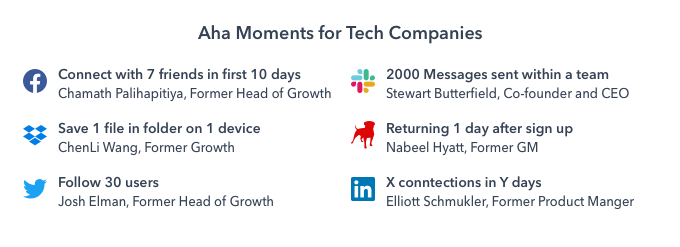Customer onboarding is key to ensuring new users engage and experience value from a product or service. Using data to deliver a personalized onboarding journey can help customers experience value more quickly, and improve customer activation and retention rates.
Much of Facebook’s early traction is attributed to what their VP of Growth, Alex Schultz described as creating a magical moment for their users. A magical moment, also known as an ‘aha moment’, happens when a customer realizes the value of a product.
For Facebook, the ‘aha moment’ was the point where new users added up to 7 friends in 10 days.
![]()
Image source
When new customers experience the ‘aha moment’, they are more likely to continue using a product, upgrade their account, and even refer more people to your business. Onboarding emails can play a vital role in helping new customers reach your product ‘aha moment’ and, in turn, improve activation rates and reduce customer churn.
Using data to create a successful customer onboarding campaign
This 3-step guide focuses on helping you creating onboarding email campaigns that guide new customers to your product ‘aha moment’.
1. Define your product ‘aha moment’
While it is called a ‘moment’, it is typically made up of a set of actions that separate users who you are likely to stick around, from those who will churn.
Bad onboarding experiences are typically the result of guessing or assuming you know what your product’s aha moment is. You’re essentially guiding your users down a path without knowing the destination.
Analyzing your customer data and conducting customer interviews can help you identify your product’s ‘aha moment’.
Analyze your customer data
In essence, you’re looking for behavioral commonalities that your most active users share with one another. Put another way, what actions correlate with retention for the majority of your users? This insight gives you a great starting point to create and test hypotheses, with the aim of identifying the set of actions that lead new customers to the ‘aha moment’ – and keeps new customers using your product for longer.
Parsa Saljoughian, Investor and former Growth Product Manager at Snap Inc., created a helpful guide on How to Discover your App’s ‘Aha Moment’ (definitely worth a read).
Conduct customer interviews
How do you know what your customers value without any input from them?
That’s a trick question; you don’t.
While customer data can give valuable quantitative insight, conducting one-to-one interviews helps add context to the data you’ve collected. You can conduct these interviews over the phone, through video calls and even in person, where possible.
Exit interviews: you can also learn a lot from users that didn’t convert to paid plans or those that churned shortly after converting. These surveys may lead you to discover insights about friction points that may have otherwise gone unnoticed.
2. Guide new customers towards the ‘aha moment’
Once you’ve defined your product’s ‘aha moment’, you can start designing an email onboarding journey to guide new customers to the set of actions that will enable them to reach it.
Mapping out the customer workflow and tracking customer interactions, will enable you to create a personalized messaging journey based on their feature usage. This will help ensure your email content is relevant to each customer’s specific stage in the journey, and encourage them to take the next step towards the ‘aha moment’.
Example email from Wistia:
![]()
Explaining multiple features at once could overwhelm a new user, explaining a feature too early and the customer is likely to forget, or even miss the email. If an email is triggered by an action taken by the customer, you can ensure the message is relevant to that specific action, and provide a clear next step/ call-to-action (CTA).
Triggering automated emails based on customer actions also prevents customers from receiving messages that encourage them to use a feature/take an action that they have already completed.
Learn how to set up behavior-based email workflows to send customers the right message, at the right time.
3. Test and optimize customer onboarding emails
Monitoring the performance of your email campaign will enable you to identify opportunities for improvement. Start by looking for emails with low engagement and conversion rates and try A/B testing the subject line, email content, or perhaps experiment sending a completely new email.
In 2017, Wistia worked with Copyhackers to improve it’s customer onboarding workflow. Through A/B testing their email onboarding campaign, Wistia observed a 350% increase in paid conversions.
Below is an example of the email changes that Wistia A/B tested.
![]()
Email and push notifications can also be used as a channel to test customer onboarding messaging that you plan to implement as a change in your product.
Testing customer messages via email and push notifications helps ensure engineering time can be allocated, and prioritized for UI messaging and workflow changes which are backed by insights that show a significant, positive impact on customer engagement, retention, and LTV.
Learn more
Onboarding email examples and best practices
Best SaaS onboarding emails
